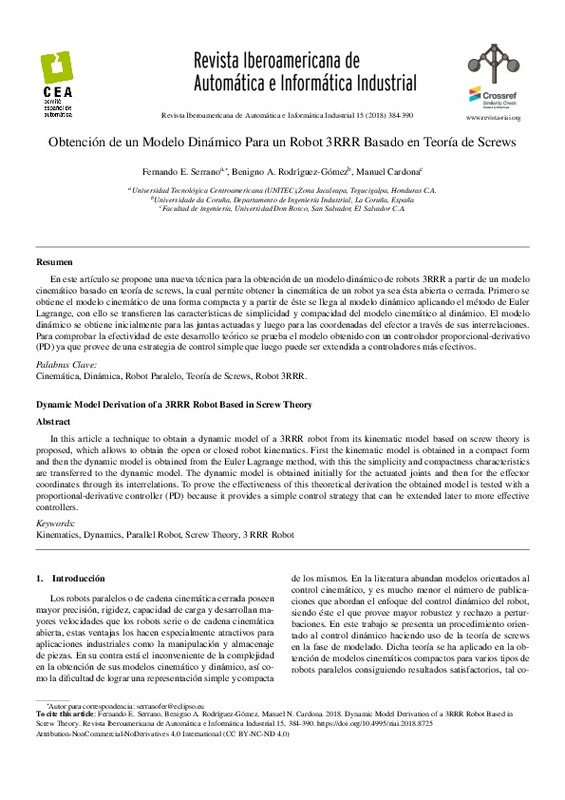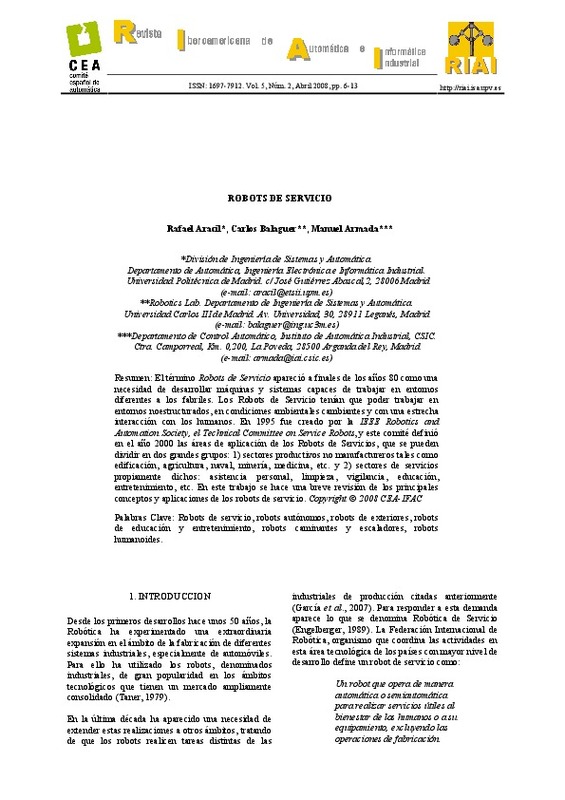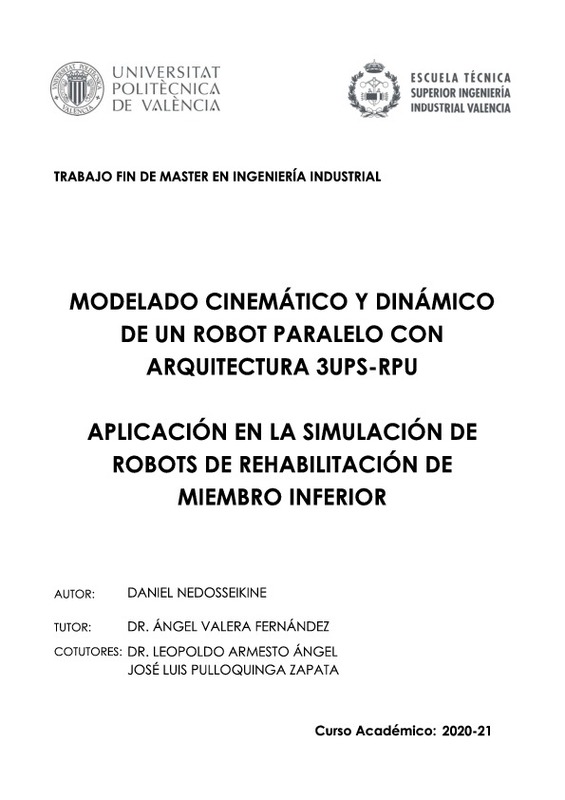JavaScript is disabled for your browser. Some features of this site may not work without it.
Buscar en RiuNet
Listar
Mi cuenta
Estadísticas
Ayuda RiuNet
Admin. UPV
Obtención de un Modelo Dinámico para un Robot 3RRR Basado en Teoría de Screws
Mostrar el registro sencillo del ítem
Ficheros en el ítem
| dc.contributor.author | Serrano, Fernando E.
|
es_ES |
| dc.contributor.author | Rodriguez, Benigno A.
|
es_ES |
| dc.contributor.author | Cardona, Manuel
|
es_ES |
| dc.date.accessioned | 2020-05-08T09:27:42Z | |
| dc.date.available | 2020-05-08T09:27:42Z | |
| dc.date.issued | 2018-09-24 | |
| dc.identifier.issn | 1697-7912 | |
| dc.identifier.uri | http://hdl.handle.net/10251/142829 | |
| dc.description.abstract | [EN] In this article a technique to obtain a dynamic model of a 3RRR robot from its kinematic model based on screw theory is proposed, which allows to obtain the open or closed robot kinematics. First the kinematic model is obtained in a compact form and then the dynamic model is obtained from the Euler Lagrange method, with this the simplicity and compactness characteristics are transferred to the dynamic model. The dynamic model is obtained initially for the actuated joints and then for the effector coordinates through its interrelations. To prove the effectiveness of this theoretical derivation the obtained model is tested with a proportional-derivative controller (PD) because it provides a simple control strategy that can be extended later to more effective controllers. | es_ES |
| dc.description.abstract | [ES] En este artículo se propone una nueva técnica para la obtención de un modelo dinámico de robots 3RRR a partir de un modelo cinemático basado en teoría de screws, la cual permite obtener la cinemática de un robot ya sea ésta abierta o cerrada. Primero se obtiene el modelo cinemático de una forma compacta y a partir de éste se llega al modelo dinámico aplicando el método de Euler Lagrange, con ello se transfieren las características de simplicidad y compacidad del modelo cinemático al dinámico. El modelo dinámico se obtiene inicialmente para las juntas actuadas y luego para las coordenadas del efector a través de sus interrelaciones. Para comprobar la efectividad de este desarrollo teórico se prueba el modelo obtenido con un controlador proporcional-derivativo (PD) ya que provee de una estrategia de control simple que luego puede ser extendida a controladores más efectivos. | es_ES |
| dc.language | Español | es_ES |
| dc.publisher | Universitat Politècnica de València | es_ES |
| dc.relation.ispartof | Revista Iberoamericana de Automática e Informática industrial | es_ES |
| dc.rights | Reconocimiento - No comercial - Sin obra derivada (by-nc-nd) | es_ES |
| dc.subject | Kinematics | es_ES |
| dc.subject | Dynamics | es_ES |
| dc.subject | Parallel Robot | es_ES |
| dc.subject | Screw Theory | es_ES |
| dc.subject | 3 RRR Robot | es_ES |
| dc.subject | Cinemática | es_ES |
| dc.subject | Dinámica | es_ES |
| dc.subject | Robot Paralelo | es_ES |
| dc.subject | Teoría de Screws | es_ES |
| dc.subject | Robot 3RRR | es_ES |
| dc.title | Obtención de un Modelo Dinámico para un Robot 3RRR Basado en Teoría de Screws | es_ES |
| dc.title.alternative | Dynamic Model Derivation of a 3RRR Robot Based in Screw Theory | es_ES |
| dc.type | Artículo | es_ES |
| dc.identifier.doi | 10.4995/riai.2018.8725 | |
| dc.rights.accessRights | Abierto | es_ES |
| dc.description.bibliographicCitation | Serrano, FE.; Rodriguez, BA.; Cardona, M. (2018). Obtención de un Modelo Dinámico para un Robot 3RRR Basado en Teoría de Screws. Revista Iberoamericana de Automática e Informática industrial. 15(4):384-390. https://doi.org/10.4995/riai.2018.8725 | es_ES |
| dc.description.accrualMethod | OJS | es_ES |
| dc.relation.publisherversion | https://doi.org/10.4995/riai.2018.8725 | es_ES |
| dc.description.upvformatpinicio | 384 | es_ES |
| dc.description.upvformatpfin | 390 | es_ES |
| dc.type.version | info:eu-repo/semantics/publishedVersion | es_ES |
| dc.description.volume | 15 | es_ES |
| dc.description.issue | 4 | es_ES |
| dc.identifier.eissn | 1697-7920 | |
| dc.relation.pasarela | OJS\8725 | es_ES |
| dc.description.references | Bartkowiak, R., Woernle, C., 2016. Necessary and sufficient mobility conditions for single-loop overconstrained nh mechanisms. Mechanism and Machine Theory 103, 65 - 84. https://doi.org/10.1016/j.mechmachtheory.2016.03.023 | es_ES |
| dc.description.references | Cardona, M. N., 2009. Analisis cinematico de robots paralelos planares 3rrr. Vigesimo novena convencion de centroamerica y panama del IEEE CONCAPAN XXIX. | es_ES |
| dc.description.references | Cardona, M. N., Feb 2015. Dimensional synthesis of 3rrr planar parallel robots for well-conditioned workspace. IEEE Latin America Transactions 13 (2), 409-415. DOI: 10.1109/TLA.2015.7055557 https://doi.org/10.1109/TLA.2015.7055557 | es_ES |
| dc.description.references | Chen, X., Liu, X.-J., Xie, F., 2015. Screw theory based singularity analysis of lower-mobility parallel robots considering the motion/force transmissibility and constrainability. Mathematical Problems in Engineering. https://doi.org/10.1155/2015/487956 | es_ES |
| dc.description.references | Liping, W., Huayang, X., Liwen, G., Yu, Z., 2016. A novel 3-puu parallel mechanism and its kinematic issues. Robotics and Computer-Integrated Manufacturing 42, 86 - 102. https://doi.org/10.1016/j.rcim.2016.05.003 | es_ES |
| dc.description.references | Lopez-Custodio, P., Rico, J., Cervantes-Sánchez, J., Pérez-Soto, G., Díez-Martínez, C., 2017. Verification of the higher order kinematic analyses equations. European Journal of Mechanics - A/Solids 61, 198 - 215. https://doi.org/10.1016/j.euromechsol.2016.09.010 | es_ES |
| dc.description.references | Mejia, L., Simas, H., Martins, D., 2016. Wrench capability in redundant planar parallel manipulators with net degree of constraint equal to four, five or six. Mechanism and Machine Theory 105, 58 - 79. https://doi.org/10.1016/j.mechmachtheory.2016.06.020 | es_ES |
| dc.description.references | Sun, T., Zhai, Y., Song, Y., Zhang, J., 2016. Kinematic calibration of a 3-dof rotational parallel manipulator using laser tracker. Robotics and Computer-Integrated Manufacturing 41, 78 - 91. https://doi.org/10.1016/j.rcim.2016.02.008 | es_ES |
| dc.description.references | Wu, A., Shi, Z., Li, Y., 2015. Formal kinematic analysis of a general 6r manipulator using the screw theory. Mathematical Problems in Engineering. https://doi.org/10.1155/2015/549797 | es_ES |
| dc.description.references | Wu, Y., Carricato, M., 2017. Identification and geometric characterization of lie triple screw systems and their exponential images. Mechanism and Machine Theory 107, 305 - 323. https://doi.org/10.1016/j.mechmachtheory.2016.09.020 | es_ES |
| dc.description.references | Xiong, T., Chen, L., Ding, J., Wu, Y., Hou, W., 2016. Recognition of kinematic joints of 3d assembly models based on reciprocal screw theory. Mathematical Problems in Engineering. https://doi.org/10.1155/2016/1761968 | es_ES |
| dc.description.references | Xu, Y., Zhang, D., Yao, J., Zhao, Y., 2017. Type synthesis of the 2r1t parallel mechanism with two continuous rotational axes and study on the principle of its motion decoupling. Mechanism and Machine Theory 108, 27 - 40. https://doi.org/10.1016/j.mechmachtheory.2016.09.007 | es_ES |
| dc.description.references | Zhao, T., Li, E., Bian, H.,Wang, C., Geng, M., 2017. Type synthesis and analysis of rotational parallel mechanisms with a virtual continuous axis. Mechanism and Machine Theory 109, 139 - 154. https://doi.org/10.1016/j.mechmachtheory.2016.09.023 | es_ES |
| dc.description.references | Zubizarreta, A., Marcos, M., Cabanes, I., Pinto, C., Portillo, E., 2012. Redundant sensor based control of the 3rrr parallel robot. Mechanism and Machine Theory 54, 1 - 17. https://doi.org/10.1016/j.mechmachtheory.2012.03.004 | es_ES |











